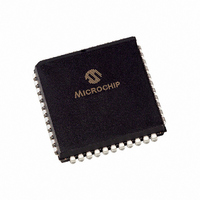PIC16LF874A-I/L Microchip Technology, PIC16LF874A-I/L Datasheet - Page 106

PIC16LF874A-I/L
Manufacturer Part Number
PIC16LF874A-I/L
Description
IC MCU FLASH 4KX14 EE A/D 44PLCC
Manufacturer
Microchip Technology
Series
PIC® 16Fr
Specifications of PIC16LF874A-I/L
Core Size
8-Bit
Program Memory Size
7KB (4K x 14)
Core Processor
PIC
Speed
10MHz
Connectivity
I²C, SPI, UART/USART
Peripherals
Brown-out Detect/Reset, POR, PWM, WDT
Number Of I /o
33
Program Memory Type
FLASH
Eeprom Size
128 x 8
Ram Size
192 x 8
Voltage - Supply (vcc/vdd)
2 V ~ 5.5 V
Data Converters
A/D 8x10b
Oscillator Type
External
Operating Temperature
-40°C ~ 85°C
Package / Case
44-PLCC
Controller Family/series
PIC16LF
No. Of I/o's
33
Eeprom Memory Size
128Byte
Ram Memory Size
192Byte
Cpu Speed
20MHz
No. Of Timers
3
Lead Free Status / RoHS Status
Lead free / RoHS Compliant
Other names
PIC16LF874A-I/LR
PIC16LF874A-I/LR
PIC16LF874AI/L
PIC16LF874A-I/LR
PIC16LF874AI/L
Available stocks
Company
Part Number
Manufacturer
Quantity
Price
Company:
Part Number:
PIC16LF874A-I/L
Manufacturer:
Microchip Technology
Quantity:
10 000
Part Number:
PIC16LF874A-I/L
Manufacturer:
MIC
Quantity:
20 000
- Current page: 106 of 234
- Download datasheet (5Mb)
PIC16F87XA
9.4.12
An Acknowledge sequence is enabled by setting the
Acknowledge
(SSPCON2<4>). When this bit is set, the SCL pin is
pulled low and the contents of the Acknowledge data bit
are presented on the SDA pin. If the user wishes to gen-
erate an Acknowledge, then the ACKDT bit should be
cleared. If not, the user should set the ACKDT bit before
starting an Acknowledge sequence. The Baud Rate
Generator then counts for one rollover period (T
and the SCL pin is deasserted (pulled high). When the
SCL pin is sampled high (clock arbitration), the Baud
Rate Generator counts for T
pulled low. Following this, the ACKEN bit is automatically
cleared, the baud rate generator is turned off and the
MSSP module then goes into Idle mode (Figure 9-23).
9.4.12.1
If the user writes the SSPBUF when an Acknowledge
sequence is in progress, then WCOL is set and the
contents of the buffer are unchanged (the write doesn’t
occur).
FIGURE 9-23:
FIGURE 9-24:
DS39582B-page 104
ACKNOWLEDGE SEQUENCE
TIMING
Note: T
Note: T
WCOL Status Flag
SCL
SDA
SSPIF
Sequence
Acknowledge sequence starts here,
SDA
SCL
Write to SSPCON2,
BRG
Falling edge of
9th clock
BRG
ACKNOWLEDGE SEQUENCE WAVEFORM
STOP CONDITION RECEIVE OR TRANSMIT MODE
= one Baud Rate Generator period.
Set SSPIF at the end
of receive
= one Baud Rate Generator period.
ACK
ACKEN = 1, ACKDT = 0
BRG
set PEN
Enable
. The SCL pin is then
write to SSPCON2
bit,
T
8
T
D0
BRG
BRG
SDA asserted low before rising edge of clock
to setup Stop condition
ACKEN
BRG
T
SCL brought high after T
BRG
)
Cleared in
software
T
BRG
P
SCL = 1 for T
after SDA sampled high. P bit (SSPSTAT<4>) is set.
ACK
T
BRG
9.4.13
A Stop bit is asserted on the SDA pin at the end of a
receive/transmit by setting the Stop Sequence Enable
bit, PEN (SSPCON2<2>). At the end of a receive/
transmit, the SCL line is held low after the falling edge
of the ninth clock. When the PEN bit is set, the master
will assert the SDA line low. When the SDA line is sam-
pled low, the Baud Rate Generator is reloaded and
counts down to 0. When the Baud Rate Generator
times out, the SCL pin will be brought high and one
T
SDA pin will be deasserted. When the SDA pin is sam-
pled high while SCL is high, the P bit (SSPSTAT<4>) is
set. A T
bit is set (Figure 9-24).
9.4.13.1
If the user writes the SSPBUF when a Stop sequence
is in progress, then the WCOL bit is set and the con-
tents of the buffer are unchanged (the write doesn’t
occur).
BRG
T
BRG
9
PEN bit (SSPCON2<2>) is cleared by
Set SSPIF at the end
of Acknowledge sequence
(Baud Rate Generator rollover count) later, the
hardware and the SSPIF bit is set
BRG
BRG
BRG
, followed by SDA = 1 for T
STOP CONDITION TIMING
later, the PEN bit is cleared and the SSPIF
ACKEN automatically cleared
WCOL Status Flag
Cleared in
software
2003 Microchip Technology Inc.
BRG
Related parts for PIC16LF874A-I/L
Image
Part Number
Description
Manufacturer
Datasheet
Request
R

Part Number:
Description:
IC MCU FLASH 4KX14 EEPROM 18SOIC
Manufacturer:
Microchip Technology
Datasheet:

Part Number:
Description:
IC MCU FLASH 4KX14 EEPROM 18DIP
Manufacturer:
Microchip Technology
Datasheet:

Part Number:
Description:
IC MCU FLASH 4KX14 EEPROM 20SSOP
Manufacturer:
Microchip Technology
Datasheet:

Part Number:
Description:
(PIC16LF87 / PIC16LF88) 18/20/28-Pin Enhanced FLASH Microcontrollers with nanoWatt Technology
Manufacturer:
Microchip Technology

Part Number:
Description:
IC MCU FLASH 4KX14 EEPROM 28QFN
Manufacturer:
Microchip Technology
Datasheet:

Part Number:
Description:
Manufacturer:
Microchip Technology Inc.
Datasheet:

Part Number:
Description:
Manufacturer:
Microchip Technology Inc.
Datasheet:

Part Number:
Description:
Manufacturer:
Microchip Technology Inc.
Datasheet:

Part Number:
Description:
Manufacturer:
Microchip Technology Inc.
Datasheet:

Part Number:
Description:
Manufacturer:
Microchip Technology Inc.
Datasheet:

Part Number:
Description:
Manufacturer:
Microchip Technology Inc.
Datasheet:











